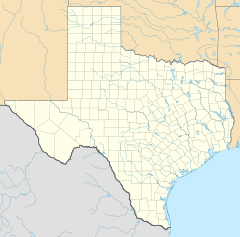- Nassau Plantation (Texas)
-
Nassau Plantation was a 4,428 acres (17.92 km2; 6.919 sq mi) endeavor purchased by the Adelsverein on January 9, 1843 in Fayette County, Texas, near what is now Round Top. Designated a Recorded Texas Historic Landmark in 1968, Marker 3550.[1]
Contents
Original purchase
The league of land was purchased near from what is now Round Top, from Robert Mills[2] by Adelsverein officers Count Ludwig Joseph von Boos-Waldeck and Count Viktor August of Leiningen-Westerburg-Alt-Leiningen,[3][4] at a cost of seventy-five cents an acre. It was named for the Archduke of Nassau, in whose castle the Adelsverein was established.[5] The acreage was developed as a full working plantation by slave labor bought by Count Boos-Waldeck in New Orleans, Galveston and Houston. When Prince Solms inspected the plantation in 1844, he recommended the Verein divest itself of the property, rather than be associated with slavery.[6]
Initially, the plantation had been considered as the primary base for arriving German immigrants, but instead they went to colonies established by Prince Carl of Solms-Braunfels and John O. Meusebach. It became a luxury noblemen's retreat for representatives of the Adelsverein. Prince Solms enjoyed horse racing and extravagant entertaining on the property.[7] John O. Meusebach resided at Nassau from April to July of 1846 to recover his health.[8]
One of the early managers of Nassau appointed by Prince Solms was Friedrich W. von Wrede Sr.[9] from Oberhausen, Germany. On October 24, 1845, Wrede and New Braunfels botanist Oscar von Claren[10] were scalped and killed by Indians while camping about ten miles from Austin.
Sale
The plantation was mis-managed and operated at a loss. It was sold, along with its existing twenty-five slaves, to Otto von Roeder.[11][12] He, in turn, sold off 800 acres (3.2 km2) undeveloped and the manor house to Peter Carl Johann von Rosenberg.[13] In 1853, Bexar County District Court ordered the Fayette County sheriff to sell the league to satisfy creditors of the Adelsverein. The sheriff sold the property to James A. Chandler on May 3, 1853. Chandler filed suit for legal title . In June 1868, Chandler recovered judgment.[14][15]
Notes
- ^ "Nassau Plantation - Round Top, Fayette County, Texas". Texas Historical Markers. William Nienke, Sam Morrow. http://www.9key.com/markers/marker_detail.asp?atlas_number=5149003550. Retrieved 29 December 2010.
- ^ Jones, Mary Beth. "Robert Mills". Handbook of Texas Online. Texas State Historical Association. http://www.tshaonline.org/handbook/online/articles/fmi39.
- ^ Brister, Louis E. "Count Victor August of Leiningen-Westerburg-Alt-Leiningen". Handbook of Texas Online. Texas State Historical Association. http://www.tshaonline.org/handbook/online/articles/fle60. Retrieved 30 December 2010.
- ^ "House of Leiningen". European Heraldry. http://www.europeanheraldry.org/house_of_leiningen.html. Retrieved 30 December 2010.
- ^ King, Irene Marschall (1967). John O.Meusebach. University of Texas Press. p. 33. ISBN 978-0292736566.
- ^ Campbell, Randolph B (1991). An Empire for Slavery: The Peculiar Institution in Texas, 1821-1865. Louisiana State University Press. p. 217. ISBN 978-0807117231.
- ^ "The Winedale Story". The Center for American History. http://www.cah.utexas.edu/exhibits/WinedaleStory/green5.html. Retrieved 29 December 2010.
- ^ King (1967), pp.90,96
- ^ Geue, Chester W. "Friedrich Wilhelm von Wrede, Sr". Handbook of Texas Online. Texas State Historical Association. http://www.tshaonline.org/handbook/online/articles/fwr21. Retrieved 30 December 2010.
- ^ Hartmann, Clinton P. "Oscar von Claren". Handbook of Texas Online. Texas State Historical Association. http://www.tshaonline.org/handbook/online/articles/fclac. Retrieved 29 December 2010.
- ^ Solms (2000) p.88
- ^ Reichstein, Andreas V (2001). German Pioneers on the American Frontier: The Wagners in Texas and Illinois. University of North Texas Press. p. 69. ISBN 978-1574411348.
- ^ von Rosenberg, Dale U. "Peter Carl Johann von Rosenberg". Handbook of Texas Online. Texas State Historical Association. http://www.tshaonline.org/handbook/online/articles/frobw. Retrieved 30 December 2010.
- ^ Garrett, Daphne Dalton. "Nassau Farm". Handbook of Texas Online. Texas State Historical Association. http://www.tshaonline.org/handbook/online/articles/acn01. Retrieved 29 December 2010.
- ^ "Nassau Plantation - Round Top, Fayette County, Texas". Texas Historical Markers. William Nienke, Sam Morrow. http://www.9key.com/markers/marker_detail.asp?atlas_number=5149003550. Retrieved 29 December 2010.
References
- Kearney, James C (2010). Nassau Plantation: The Evolution of a Texas German Slave Plantation. University of North Texas Press. ISBN 978-1574412864.
- Solms, Carl; Gish, Theodore G; Von-Maszweski, Wolfram M (2000). Voyage to North America, 1844-45: Prince Carl of Solms' Texas Diary of People, Places, and Events. University of North Texas Press. ISBN 978-1574411249.
- King, Irene Marschall (1967). John O.Meusebach. University of Texas Press. ISBN 978-0292736566.
Coordinates: 30°05′57″N 96°37′08″W / 30.09917°N 96.61889°W
Categories:- German diaspora
- Recorded Texas Historic Landmarks
- Slavery in the United States
- German-American history
- Fayette County, Texas
Wikimedia Foundation. 2010.

